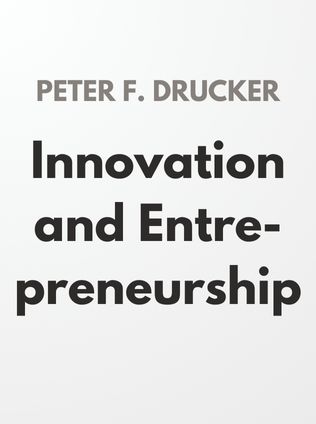
Innovation and Entrepreneurship
By Peter F. Drucker
Published 01/1985
About the Author
Peter F. Drucker (1909-2005) is one of the most celebrated and influential thinkers in the field of modern management. Born in Austria and later becoming a U.S. citizen, Drucker’s work has shaped the landscape of business and organizational practices for decades. His unique approach to management emphasized the human element, seeing employees not just as cogs in a machine, but as valuable assets that could drive innovation and growth. His prolific career spanned more than six decades, during which he authored numerous seminal books including The Effective Executive, Managing Oneself, and The Essential Drucker.
Drucker’s insights are drawn from a wealth of experience, both as a management consultant and as a professor at institutions like New York University and Claremont Graduate University, where the Drucker School of Management is named in his honor. His work is characterized by a deep understanding of both the practical and philosophical aspects of management, offering strategies that are as relevant today as they were when first penned. In Innovation and Entrepreneurship, published in 1985, Drucker explores the vital role that innovation plays in economic and social development, offering a roadmap for entrepreneurs and businesses looking to thrive in a rapidly changing world.
Main Idea
The core message of Peter F. Drucker’s Innovation and Entrepreneurship is that innovation is not a random act of genius, but a systematic, disciplined process that can be learned and applied by anyone willing to engage with it thoughtfully. Drucker argues that entrepreneurship is not merely about starting a business; it’s about fostering a mindset that constantly seeks out opportunities for improvement and is willing to challenge the status quo. He dispels the myth of the entrepreneur as a lone visionary, instead positioning them as thoughtful, methodical individuals who understand the importance of hard work, research, and structured planning in bringing new ideas to market.
Drucker’s insights are particularly valuable because they demystify the process of innovation, making it accessible to individuals and organizations of all sizes. He emphasizes that innovation is not solely about technological advancements; it can also be found in new ways of organizing, managing, or even perceiving a business. The book serves as a guide for understanding the types of innovation, identifying opportunities, and implementing strategies to successfully introduce new ideas to the market.
Table of Contents
- The Entrepreneurial Mindset
- Gearing Up for Innovation
- Innovation-Centered Leadership
- Where to Find Innovation
- Bringing Innovation to the Market
- Management for Entrepreneurial Startups
The Entrepreneurial Mindset
At the heart of Innovation and Entrepreneurship is the idea that entrepreneurship is not just about starting a new business but about a mindset that embraces change, challenges existing norms, and seeks out opportunities to innovate. Drucker argues that the essence of entrepreneurship lies in the ability to create new markets and new customers, not just through the introduction of novel products, but by changing the way business is conducted.
Drucker emphasizes that entrepreneurship is a universal skill, not confined to small startups or tech giants. Even large, established corporations can (and should) adopt an entrepreneurial mindset to stay relevant in a changing world. He expands the definition of entrepreneurship to include not just the private sector but also nonprofits and government organizations, arguing that all sectors of society can benefit from entrepreneurial thinking.
Innovation, according to Drucker, is the tool that entrepreneurs use to create value and drive progress. It involves transforming resources—whether material, human, or financial—into something of greater value. This transformation is not limited to creating new products but can also include new business models, processes, or social institutions. The key, Drucker argues, is to approach innovation systematically, treating it as a discipline rather than relying on sporadic bursts of inspiration.
The Entrepreneurial Spirit in Action
Entrepreneurship manifests in various forms:
- Product Innovation: Developing new or improved products that meet emerging consumer needs.
- Process Innovation: Introducing more efficient ways of doing business, from production to distribution.
- Market Innovation: Identifying and exploiting new markets, sometimes by repurposing existing products.
- Organizational Innovation: Creating new structures or cultures within organizations to improve performance and adaptability.
Each of these forms of innovation requires a deep understanding of the market, a willingness to experiment, and a commitment to continuous improvement. Drucker stresses that the most successful entrepreneurs are those who see change as an opportunity rather than a threat.
Sign up for FREE and get access to 1,400+ books summaries.
You May Also Like
Rich Dad Poor Dad
What the Rich Teach Their Kids About Money - That the Poor and Middle Class Do Not!
By Robert T. KiyosakiFreakonomics
A Rogue Economist Explores the Hidden Side of Everything
By Steven D. Levitt and Stephen J. DubnerThe Lean Startup
How Today's Entrepreneurs Use Continuous Innovation to Create Radically Successful Businesses
By Eric RiesWho Moved My Cheese?
An Amazing Way to Deal with Change in Your Work and in Your Life
By Spencer Johnson, M.D.Factfulness
Ten Reasons We're Wrong About the World – and Why Things Are Better Than You Think
By Hans RoslingMake Your Bed
Little Things That Can Change Your Life...And Maybe the World
By William H. McRaven



















